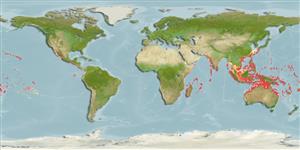>
Tetraodontiformes (Puffers and filefishes) >
Monacanthidae (Filefishes)
Etymology: Cantherhines: Greek, kanthos = the outer or inner corner of the eye, where the lids meet, 1646 + Greek, rhinos = nose (Ref. 45335).
Eponymy: Dr André Marie Constant Duméril (1774–1860) was a French zoologist who qualified as a physician (1793). [...] (Ref. 128868), visit book page.
Environment: milieu / climate zone / depth range / distribution range
Οικολογία
Θαλασσινό(ά) Υφαλόφιλο(α); μη μεταναστευτικό(ά); εύρος βάθους 0 - 70 m (Ref. 89467), usually 6 - 35 m (Ref. 9710). Tropical; 32°N - 32°S
Indo-Pacific: East Africa to French Polynesia, north to Japan and Hawaii. Eastern Pacific: Mexico to Colombia (Ref. 9318).
Μέγεθος / Βάρος / Age
Maturity: Lm ? range ? - ? cm
Max length : 38.0 cm TL αρσενικό/απροσδιόριστο; (Ref. 30573); common length : 25.0 cm TL αρσενικό/απροσδιόριστο; (Ref. 30573)
Short description
Κλείδες προσδιορισμού | Μορφολογία | Μορφομετρία
Ραχιαίες άκανθες (συνολικά) : 2; Μαλακές ραχιαίες ακτίνες (συνολικά) : 34 - 39; Εδρικές άκανθες: 0; Μαλακές εδρικές ακτίνες: 28 - 35. Greyish brown to yellowish brown with about 12 vertical dark brown bars; lips whitish; male adults with orange peduncle spines; soft dorsal, anal and pectoral fins pale yellowish; caudal fin orange with dusky rays (Ref. 4421). Sexually dimorphic with males having longer and deeper orange peduncular spines and deeper orange tail and eyes (Ref. 37816).
Inhabit offshore coral reefs usually solitary or in pairs (Ref. 5503, 48637). Common in surface waters around oceanic islands (Ref. 9318). Benthopelagic (Ref. 58302). Shy species, usually retreating quickly into caves or large crevices of the reef (Ref. 48637). Juveniles are pelagic, seen under floating objects (Ref. 9318). Feed on tips of branching corals, algae, sponges, sea urchins, and mollusks (Ref. 1602). Minimum depth reported taken from Ref. 128797.
Life cycle and mating behavior
Γεννητική Ωρίμανση | Αναπαραγωγή | Γεννοβολία | Αβγά | Γονιμότητα | Προνύμφες
Myers, R.F., 1991. Micronesian reef fishes. Second Ed. Coral Graphics, Barrigada, Guam. 298 p. (Ref. 1602)
IUCN Red List Status (Ref. 130435: Version 2024-2)
Threat to humans
Harmless
Human uses
αλιεία: Εμπορικό(ά); Ενυδρείο: Εμπορικό(ά)
Εργαλεία
Special reports
Download XML
Διαδικτυακές πηγές
Estimates based on models
Preferred temperature (Ref.
123201): 24.3 - 28.9, mean 27.6 °C (based on 1090 cells).
Phylogenetic diversity index (Ref.
82804): PD
50 = 0.5002 [Uniqueness, from 0.5 = low to 2.0 = high].
Bayesian length-weight: a=0.02399 (0.01377 - 0.04179), b=2.93 (2.78 - 3.08), in cm total length, based on LWR estimates for this species & (Sub)family-body (Ref.
93245).
Τροφικό Επίπεδο (Ref.
69278): 3.1 ±0.33 se; based on food items.
Ελαστικότητα (Ref.
120179): Μεσαίο(α), ελάχιστος χρόνος για διπλασιασμό πληθυσμού 1,4 - 4,4 έτη (Preliminary K or Fecundity.).
Fishing Vulnerability (Ref.
59153): Low to moderate vulnerability (28 of 100).
Nutrients (Ref.
124155): Calcium = 24.5 [7.4, 74.5] mg/100g; Iron = 0.747 [0.264, 2.049] mg/100g; Protein = 18.1 [15.9, 20.3] %; Omega3 = 0.0791 [, ] g/100g; Selenium = 52.1 [19.6, 143.4] μg/100g; VitaminA = 52.1 [14.7, 187.9] μg/100g; Zinc = 1.59 [0.74, 2.80] mg/100g (wet weight);
